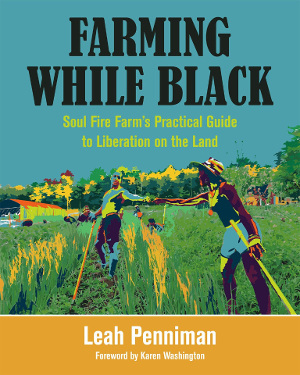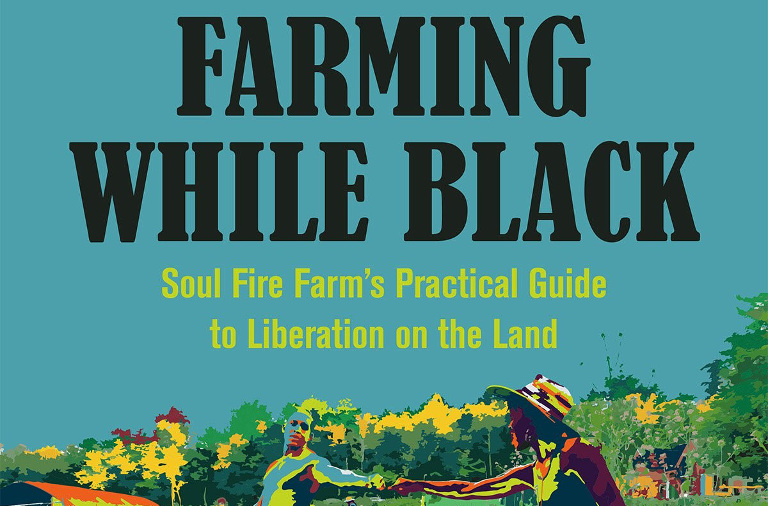 The following excerpt is from Leah Penniman’s book Farming While Black: Soul Fire Farm’s Practical Guide to Liberation on the Land (Chelsea Green Publishing, November 2018) and is reprinted with permission from the publisher.
The following excerpt is from Leah Penniman’s book Farming While Black: Soul Fire Farm’s Practical Guide to Liberation on the Land (Chelsea Green Publishing, November 2018) and is reprinted with permission from the publisher.
At the Woodbourne Correctional Facility in upstate New York, guest teachers are not allowed to use red markers, and all images must be approved by the administrators in advance. Jonah and I worked within these and dozens of other regulations as we prepared our “farming and food justice” workshop for the incarcerated individuals who were earning their college degree through the Bard Prison Initiative.
On our way to the prison, we drove through one economically depressed rural Hudson Valley town after another, each one less resourced than the previous one. A few houses dotted the road, laundry hanging over sagging porches. We felt the painful irony that the Woodbourne Correctional Facility sat, quite literally, on land that once produced food. The land was now perverted as a tool for tearing apart our communities and draining its resources.
We passed through razor wire and triple locks, fingerprinting and white guards, peeling paint and 1970s encyclopedias, and caged humans. Thirty men, almost all Black or Latinx, attended our class. They told stories of gardening with their grandmothers, climbing mango trees at home in Puerto Rico, and running their family farms in the South. Bolstered by these memories, we got to work on business plans for the farm and food enterprises they planned to create once they were out.
Upstate New York was once home to thriving trade routes and prosperous dairy farms. The US Department of Agriculture’s destruction of parity pricing and its “get big or get out” policies since the 1950s undermined the small-farm economy and incentivized consolidation. As agriculture declined in the area, the prison industry rose to take its place. New York State Department of Corrections is the state’s largest agency, with a 2017 budget of $3.182 billion. Politicians representing the towns where prisons are located vehemently protect this bloated industry and the jobs it provides in their mostly white communities.
These remote upstate New York prisons are filled with people of color from New York City, despite evidence that keeping close ties to one’s community and family decreases recidivism. While the majority of drug users and sellers in the state are white, 90 percent of people locked up for drug offenses are Black and Latinx. The result is a dysfunctional relationship between racist criminal justice policy and economic stability. The prison system harms rural communities because it ignores economic devastation and sidesteps development policy. It harms urban communities by kidnapping their people and reinforcing institutional racism. It harms us both by pitting our basic needs—for economic survival and freedom—against each other.
Working-class Black and white people have long understood that we are natural allies, and the owning class has done everything in their power to invent and promote racist ideas to divide us. Bacon’s Rebellion in 1676 occurred when Black and white indentured servants took up arms against the landed gentry of the Virginia House of Burgesses. This interracial militia captured Jamestown and burned it to the ground. Word of the rebellion spread far and wide, and several more uprisings ensued. The planter elite were alarmed and deeply fearful of alliance between their workers, so they enacted laws that permanently enslaved Virginians of African descent and gave poor white indentured servants new rights and status. The white rebels were pardoned and the Black rebels were punished, further cementing the racial divide.
Despite violent attacks by elite forces, poor whites and Blacks continued to organize together. They formed the Southern Tenant Farmers Union, an interracial alliance demanding their fair share of subsidies and profits, and improved working conditions. Harrison George of the Communist Party remarked in 1932, “The impoverished farmers are on the march. We cannot order them to retreat, even if we desired.”
Our generation must carry on this march. White supremacy erodes our humanity and is our common enemy. The white elite created white supremacy, a “historically based, institutionally perpetuated system of exploitation and oppression of continents, nations, and peoples of color by white peoples and nations of the European continent for the purpose of establishing, maintaining and defending a system of wealth, power and privilege.” White supremacy infuses all aspects of society including our history, culture, politics, economics, and entire social fabric, producing cumulative and chronic adverse outcomes for people of color. What can be created, can be destroyed. White people need to be active in the dismantling of white supremacy.
Black food and land sovereignty is the collective responsibility of the entire community, not just the purview of African American people. This chapter offers strategies for European heritage people to examine their privilege and take concrete action to uproot personal and institutional racism. We explore strategies for enacting reparations, forming alliances, transforming organizations, “calling in” oppression, and connecting with our personal histories. Recognizing that, as historian Howard Zinn once said, “you can’t be neutral on a moving train,” this chapter offers steps to actively work against the grain in your spheres of influence and start to undo the harms of racism.
Reparations
Enslaved Africans never received reparations for their unpaid labor or broken families. The promise “40 acres and a mule” during Reconstruction was retracted. In fact, some white plantation owners received reparations for their “lost property.” If African American people were paid $20 per week for our agricultural labor rather than enslaved, we would have $6.4 trillion in today’s dollars in the bank right now. This figure does not include reparations for denied credit and homeownership opportunities, exclusion from the social safety net and education, or property theft and destruction. There is a reason why the typical white household has 16 times the wealth of a typical black household: 80 percent of wealth is inherited, often traceable back to slavery times. Existing policies reinforce and augment the wealth gap.
The most important action that white people can take to uproot racism is to enact reparations, to quite literally give back what was stolen. We are not talking about Georgetown University–style reparations, where the institution gave a formal apology and preferential admission to the descendants of people sold as slaves in 1838, but did not offer scholarships or include the descendants in the reparations committee. We are talking about true reparations, which have the following three characteristics:
- “Nothing about us, without us”: Black people get to define what reparations look like.
- “No strings attached”: Transfers of land and resources without oversight or conditionality.
- “The whole pie”: Give the land, money, and jobs away, even and especially when it entails personal sacrifice.
Take stock of your resources, including your job, assets, property, and power. Ask yourself what you can give away in a loving act of reparations. Can you job-share with a community member and then hand over the reins once that person learns the ropes? Can you give away your land and downsize your living arrangements? Can you eliminate superfluous expenses and give that money away to front-line organizations? Can you convince other people with money and power to align their actions with the priorities of front-line communities? Black and Indigenous members of the Northeast Farmers of Color Network and Soul Fire Farm alumni put together a reparations map (www.soulfirefarm.org/support/reparations) to channel these resources directly to people of color working on farming and food justice projects. Users can explore the map and contact one another directly to transfer resources.
Reparations also entails working for policy changes that undermine the systemic nature of the wealth gap. The following are among the policies for which we should advocate.
- Pass HR 40: Commission to Study and Develop Reparation Proposals for African-Americans Act.
- Guarantee a “Universal Basic Income”—a minimum livable income to cover the costs of food, shelter, education, transportation, and health care.
- Provide free and universal education, from pre-K through university.
- Increase federal and state investments in historically Black colleges and universities.
- Eliminate the down payment for home buyers of color and provide foreclosure interventions.
- Enforce housing antidiscrimination laws.
- Cap the mortgage interest tax deduction.
- Tax all income for Social Security, not just the first $128,400, and raise the payout to low-income earners.
- Close loopholes like “step up” that allow people to avoid paying tax on property they inherit.
- Enact affirmative action in colleges and universities.
- Provide equitable funding for public schools across districts.
- Raise the minimum wage and Social Security payouts.
- Provide free and universal health care.
- Grant the right to unionize for all employees.
- Enact a progressive restructuring of tax codes at the local, state, and federal levels.
- Divest from the criminal injustice system, and invest in restorative justice, mental health services, and job programs.
- End money bail and capital punishment.
Finally, reparations demands that we release the frontier mentality that plagues progressive spaces. The frontier mentality is the erroneous idea that the way to solve existing problems is to create or grow an initiative led by white people, rather than support existing projects led by front-line communities. This myth is rooted in the frontier mind-set of European colonizers who romanticized the “Wild West” as an “unsettled” area with unlimited free land and opportunity. This myth drove the brutal exploitation of Indigenous people, Mexican Americans, and Blacks and the exploitation of natural resources. To release the frontier mentality, we must follow the lead of people of color. Logically, those harmed directly by racism are the same people who know best how to remedy that harm.
Sometimes “following the lead” of people of color means doing unglamorous tasks behind the scenes that fortify the work but do not garner recognition. My partner, Jonah, is currently the only white-
identified person working at Soul Fire Farm, and I watch him fix toilets, trap ants, repair leaks, organize paperwork, and order supplies, while others facilitate programs and give public talks to much acclaim.
He has quite literally dedicated his life to building the infrastructure to support a people-of-color-led liberation project. Similarly, I witness the White Noise Collective cook food and prepare spaces for Harriet’s Apothecary, a Black-led space. They disappear during the healing event and return when it finishes to clean up and give our guests rides to the train station.
A first step is to find out what Black-led organizations are working toward liberation in your area and see what you can do to support.





